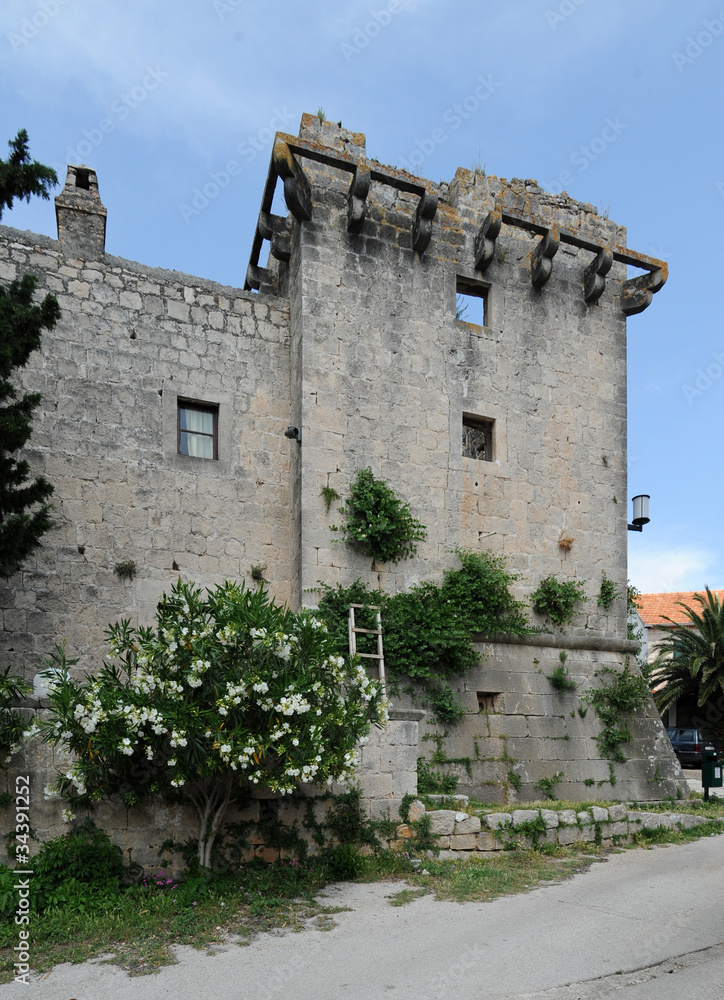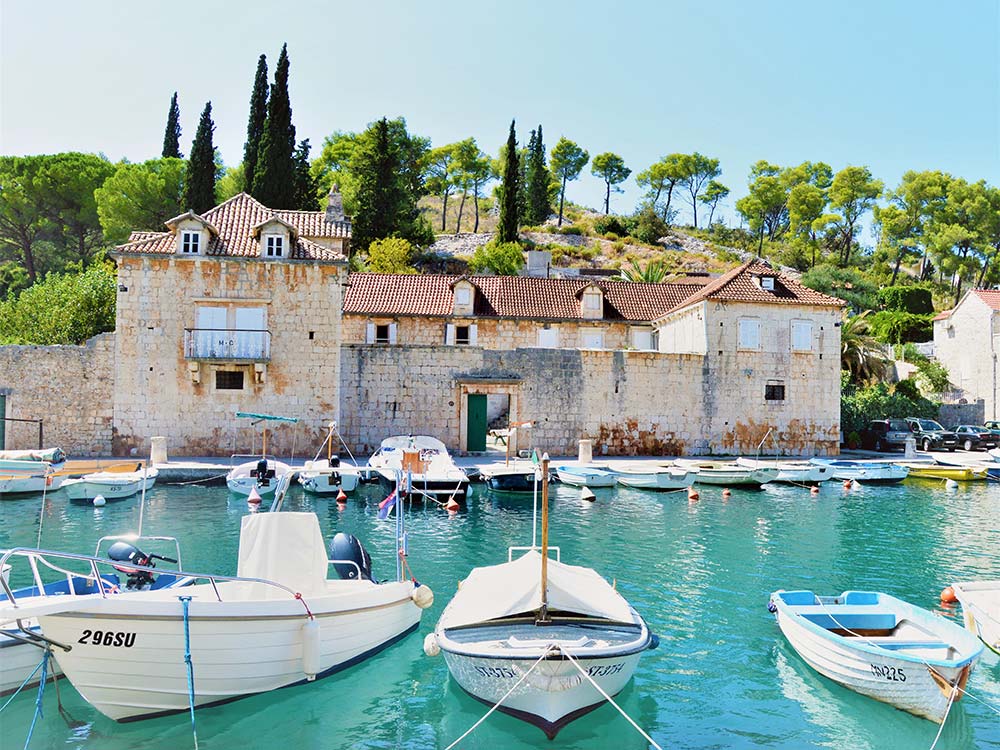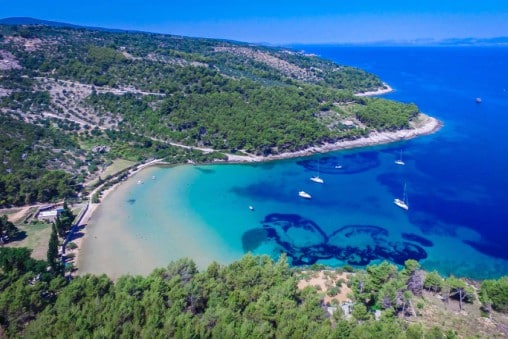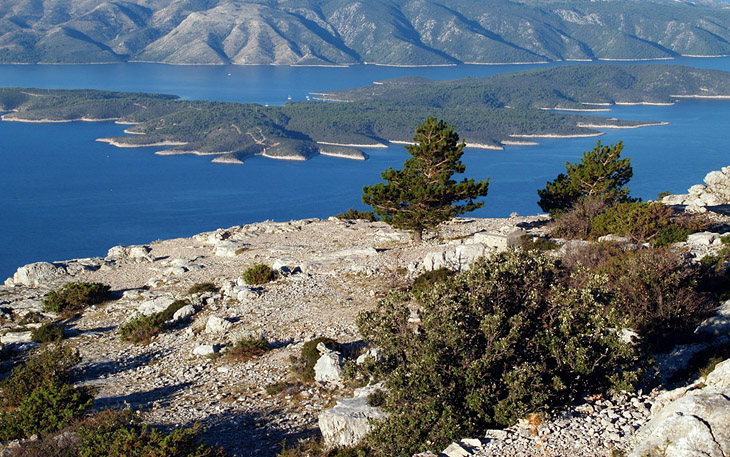The island of Brač is 40 km long and 13 km wide, has 175 km of coastline, an area of 394 sq km, and has a typical Mediterranean climate-it is the third largest island in the Croatian Adriatic and the largest among those in Central Dalmatia. It is divided from the neighboring island of Solta by the Solta Channel or Splitska Vrata (Gateway to Split), which is about 500 m wide, while from the mainland it is separated by the Brac Channel (Bracki Kanala) and the Split Channel (Splitski Kanal), and the mediirional part of the island faces the Hvar Channel (Hvarski Kanal).
The northern side of the island has a typical karst appearance, with valleys and ridges, in the central part are concentrated vineyards, while around the villages abound vegetable gardens, olive groves and orchards of the famous marasca cherries that are used for the production of the renowned and appreciated “Maraschino.”
There are 22 villages on the island of which 12 are inhabited and 5 abandoned all connected with paved roads. The island is well connected to the mainland by a ferry and catamaran line to Split (Split-Supetar line) and Makarska (Makarska-Sumartin line) that makes trips several times a day. Brac Airport is 10km from Bol, and in the summertime the island is connected to almost all major European cities. The island’s productive activity, in addition to livestock farming and the cultivation of vines and olive trees, is the extraction of white stone from quarries. In fact, many illustrious buildings have been built with Brac’s white stone – Diocletian’s palace in Split and more recently the White House in Washington.The island’s vegetative cover is dominated by elk, Aleppo pine and black pine. There are more than three hundred species of birds including resident and seasonal migrants and the dormouse, the island’s symbol.
The length of the island can be traveled by a road from which detours descend to villages, among which the most interesting are: Bol, Bobovisca, Dol, Lozisca, Milna, Nerezisca, Postira, Povlja, Prasnice, Pucisca, Selca, Splitska, Sutivan, Sumartin, Supetar, Skrip, Donji and Gornji Humac, and Novo Selo.
There are many archaeological sites on the island with artifacts from Roman times, but also of great importance are an early Christian basilica in Povlja (St. John the Baptist), Lovrecina, Supetar, Postire and Pucisca and the Franciscan monastery in Sumartin, Shops are open from 8 to 8/21. Post offices are open from 7 a.m. to 7 p.m. and on Saturdays until 1 p.m.
Must-see:
– Vidova Gora – is a mountain located on the south coast of the island of Brac. At 778 m high, it is the highest mountain of all Croatian Adriatic islands. From its top there is a wonderful view of the Central Dalmatian islands especially Hvar and Vis and Zlatn i Rat beach. Vidova Gora is covered with Dalmatian black pine forest and is crisscrossed by numerous hiking and biking trails.
– Blaca – is an abandoned monastery located at the foot of a steep cliff; today it houses the Museum of Brac.In addition to being a valuable monument, it houses an extensive library, a small printing press, and an astronomical observatory. The monastery had its own school.
– Lovrecina – a bay with a sandy beach near Pucisca, is also an archaeological site rich in finds. The remains of an early Christian church with a cross-shaped plan are visible; on the north side is the baptismal font and above it a ciborium on four pillars and stone capitals.
– Marincevic-Gligo Castle – located in Bobovisca, on the southern side of the harbor square, is built in the Renaissance style.
– Kopacina Cave – is located near Donji Humac, the site of many archaeological finds.
– The Pilo of N erezisca – is located in the center of the village of Nerezisca, in the square and was used by the Venetians to hoist their banner; on the column you can still see the lion of St. Mark with an inscription dated 1545.
– Cerinic Castle – is located on the eastern shore of Splitska Bay called Bok, dates back to 1577 and holds some artwork from the 400s and 500s.
– Dragon Cave-known as Drakonjina Cave-there are Glagolitic reliefs and drawings dating back to the 15th century. Located 200m from the village Murvica, this cave was also used as a hermitage and temple.
– Gazul – shepherds’ village on the plateau; the village is abandoned in winter, while in summer it is possible to visit and taste traditional dishes.
– Count’s Castle – located in Bol, is a 15th-century palace with Gothic-style mullioned windows on the south facade.
– St. Mary’s Church and Milna Castle-the church was built in the 16th century and the castle is known as Angliscina because it was built by an English lord.
– St. Martin’s Monastery – located in Sumartin, it was built in the 18th century and houses the archives, library with ancient books and incunabula, and some 17th-century paintings.
– Castelletto Marijanovic – is located in Sutivan and was erected in the seventeenth century in the inner part of the mandrake; it is a squat stone building with a square base and barbicans and has a sundial on its facade.




